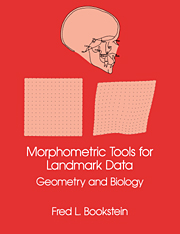4 - Distance measures
Published online by Cambridge University Press: 23 November 2009
Summary
For a data set comprising locations of homologous landmarks in a sample of forms, the simplest size variable is the distance between a pair of landmarks. This chapter considers, in addition to the discrete landmarks presented by the data, the constructed landmarks, arbitrarily weighted centroids of sets of landmarks, and the set of all distances measured between pairs of these. For shapes constrained to a sufficiently modest range, this set of distances behaves like a linear vector space. Of special interest is the size variable S that is the summed-squared distance between pairs of landmarks. S is a multiple of the spatial variance of the landmarks of a single form about their common centroid.
The construction of this space of distance measures is necessary mainly so that the next chapter can introduce a statistical structure for the collection of all their ratios. This chapter introduces one specific class of multivariate models that can be handled by linear combinations of distances alone, without the passage to ratios: the path modeling of lists of distances by multiple morphological explanations (factors), including General Size. These models, implemented via factor analysis and analysis of covariance, apply as well to size data that are not distances between homologous landmarks. We shall see how questions about ratios arise naturally by inspection of residuals from certain path models applying to data in the form of distances. Although rearrangement of the analyses of covariance suggests that explanations might proceed further in terms of shape measurements like these ratios, those extensions require that we exploit the geometry of landmark data more extensively than by studying only covariances of distances.
- Type
- Chapter
- Information
- Morphometric Tools for Landmark DataGeometry and Biology, pp. 88 - 124Publisher: Cambridge University PressPrint publication year: 1992
- 1
- Cited by



